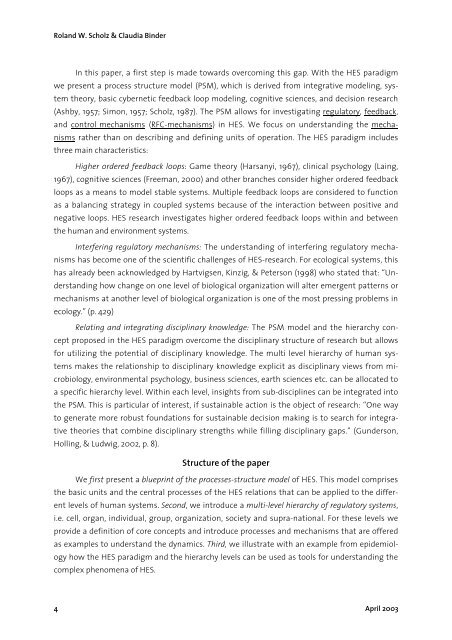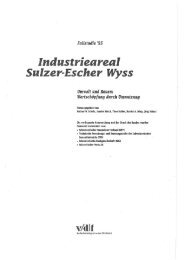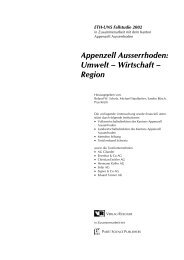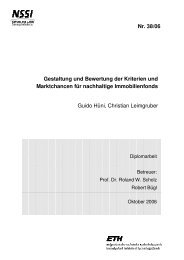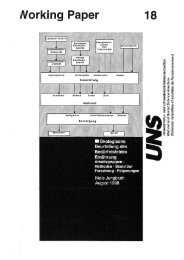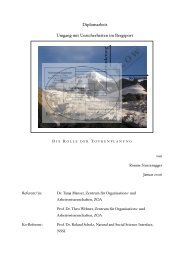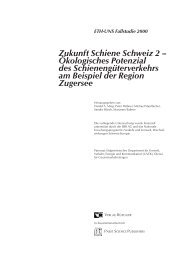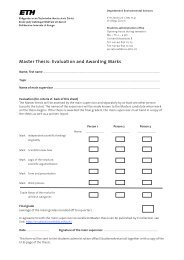The Paradigm of Human-Environment Systems - Natural and Social ...
The Paradigm of Human-Environment Systems - Natural and Social ...
The Paradigm of Human-Environment Systems - Natural and Social ...
You also want an ePaper? Increase the reach of your titles
YUMPU automatically turns print PDFs into web optimized ePapers that Google loves.
Rol<strong>and</strong> W. Scholz & Claudia Binder<br />
In this paper, a first step is made towards overcoming this gap. With the HES paradigm<br />
we present a process structure model (PSM), which is derived from integrative modeling, system<br />
theory, basic cybernetic feedback loop modeling, cognitive sciences, <strong>and</strong> decision research<br />
(Ashby, 1957; Simon, 1957; Scholz, 1987). <strong>The</strong> PSM allows for investigating regulatory, feedback,<br />
<strong>and</strong> control mechanisms (RFC-mechanisms) in HES. We focus on underst<strong>and</strong>ing the mecha-<br />
nisms rather than on describing <strong>and</strong> defining units <strong>of</strong> operation. <strong>The</strong> HES paradigm includes<br />
three main characteristics:<br />
Higher ordered feedback loops: Game theory (Harsanyi, 1967), clinical psychology (Laing,<br />
1967), cognitive sciences (Freeman, 2000) <strong>and</strong> other branches consider higher ordered feedback<br />
loops as a means to model stable systems. Multiple feedback loops are considered to function<br />
as a balancing strategy in coupled systems because <strong>of</strong> the interaction between positive <strong>and</strong><br />
negative loops. HES research investigates higher ordered feedback loops within <strong>and</strong> between<br />
the human <strong>and</strong> environment systems.<br />
Interfering regulatory mechanisms: <strong>The</strong> underst<strong>and</strong>ing <strong>of</strong> interfering regulatory mechanisms<br />
has become one <strong>of</strong> the scientific challenges <strong>of</strong> HES-research. For ecological systems, this<br />
has already been acknowledged by Hartvigsen, Kinzig, & Peterson (1998) who stated that: “Underst<strong>and</strong>ing<br />
how change on one level <strong>of</strong> biological organization will alter emergent patterns or<br />
mechanisms at another level <strong>of</strong> biological organization is one <strong>of</strong> the most pressing problems in<br />
ecology.” (p. 429)<br />
Relating <strong>and</strong> integrating disciplinary knowledge: <strong>The</strong> PSM model <strong>and</strong> the hierarchy concept<br />
proposed in the HES paradigm overcome the disciplinary structure <strong>of</strong> research but allows<br />
for utilizing the potential <strong>of</strong> disciplinary knowledge. <strong>The</strong> multi level hierarchy <strong>of</strong> human systems<br />
makes the relationship to disciplinary knowledge explicit as disciplinary views from microbiology,<br />
environmental psychology, business sciences, earth sciences etc. can be allocated to<br />
a specific hierarchy level. Within each level, insights from sub-disciplines can be integrated into<br />
the PSM. This is particular <strong>of</strong> interest, if sustainable action is the object <strong>of</strong> research: “One way<br />
to generate more robust foundations for sustainable decision making is to search for integrative<br />
theories that combine disciplinary strengths while filling disciplinary gaps.” (Gunderson,<br />
Holling, & Ludwig, 2002, p. 8).<br />
Structure <strong>of</strong> the paper<br />
We first present a blueprint <strong>of</strong> the processes-structure model <strong>of</strong> HES. This model comprises<br />
the basic units <strong>and</strong> the central processes <strong>of</strong> the HES relations that can be applied to the different<br />
levels <strong>of</strong> human systems. Second, we introduce a multi-level hierarchy <strong>of</strong> regulatory systems,<br />
i.e. cell, organ, individual, group, organization, society <strong>and</strong> supra-national. For these levels we<br />
provide a definition <strong>of</strong> core concepts <strong>and</strong> introduce processes <strong>and</strong> mechanisms that are <strong>of</strong>fered<br />
as examples to underst<strong>and</strong> the dynamics. Third, we illustrate with an example from epidemiology<br />
how the HES paradigm <strong>and</strong> the hierarchy levels can be used as tools for underst<strong>and</strong>ing the<br />
complex phenomena <strong>of</strong> HES.<br />
4 April 2003


